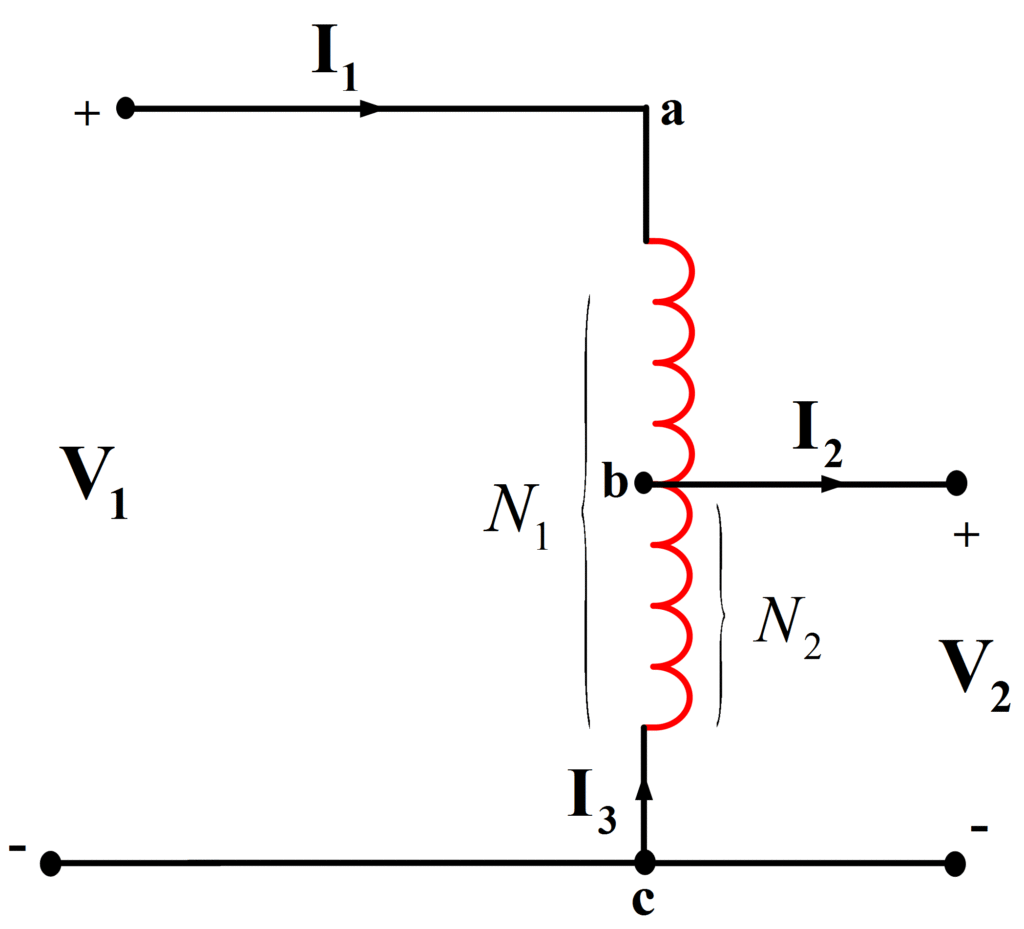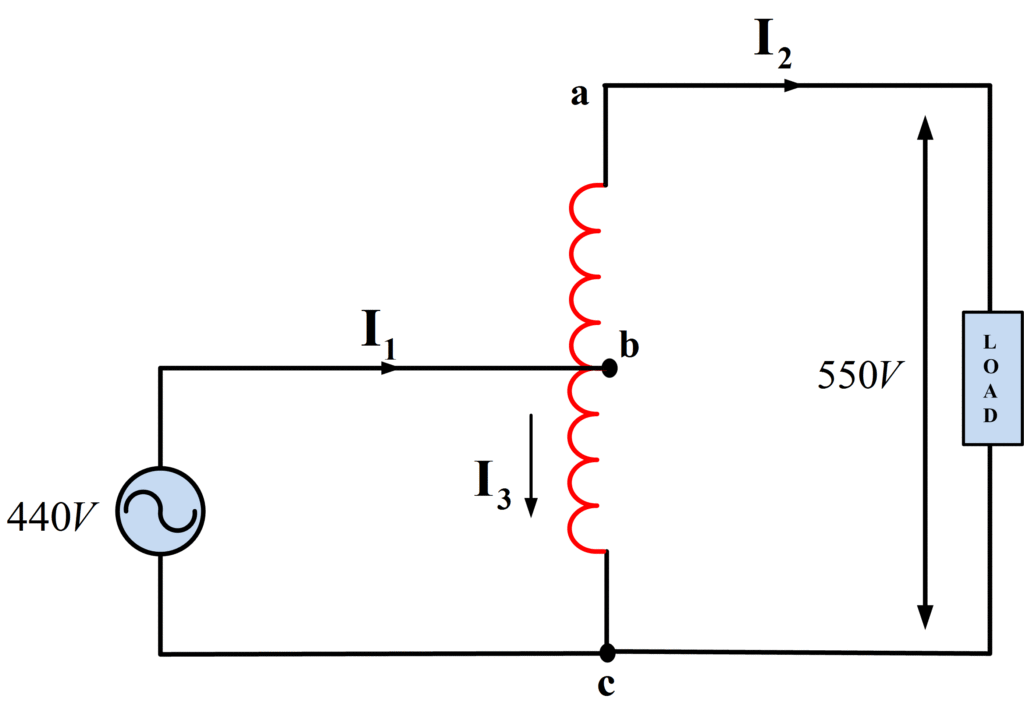Autotransformer Definition
The autotransformer has a single winding on an iron core. One of the coil terminals is common to both input and output, and the other output terminal is movable so that it can make contact with any turn on the winding.
Step-Up/ Step-Down Autotransformer
An autotransformer can be used as a step-up or a step-down transformer. As a step-up, it is often referred to as a boost, and as a step-down, it is called a buck connection. Figure 1 shows the schematic representation of buck connection while figure 2 shows the boost connection.
Autotransformer Operation
The autotransformer serves a function similar to that of the ordinary transformer to raise or lower voltage. It consists of a single continuous winding with a tap brought out at some intermediate point as shown in Fig.1. Because the primary and secondary windings of the autotransformer are physically connected, the supply and output voltage are not insulated from each other.

Figure.1: Autotransformer Circuit Diagram
When a voltage V1 is applied to the primary of the autotransformer, the induced voltages are related by
\[\begin{matrix} \frac{{{E}_{1}}}{{{E}_{2}}}=\frac{{{E}_{ac}}}{{{E}_{bc}}}=\frac{{{N}_{1}}}{{{N}_{2}}}=a & {} & \left( 1 \right) \\\end{matrix}\]
Neglecting voltage drops in the windings
\[\begin{matrix} \frac{{{V}_{1}}}{{{V}_{2}}}=a & {} & \left( 2 \right) \\\end{matrix}\]
When a load is connected to the secondary of the autotransformer, a current I2 flows in the direction shown in Fig.1. By Kirchhoff’s current law,
\[\begin{matrix} {{I}_{2}}={{I}_{1}}+\text{ }{{I}_{3}} & {} & \left( 3 \right) \\\end{matrix}\]
As in the ordinary transformer, the primary and secondary ampere-turns balance each other, except for the small current required for core magnetization:
\[\begin{matrix} {{N}_{1}}{{I}_{1}}={{N}_{2}}{{I}_{2}} & {} & (4) \\\end{matrix}\]
Equation 4 may also be written as
\[\begin{matrix} \frac{{{I}_{2}}}{{{I}_{2}}}~=\frac{{{N}_{1}}}{{{N}_{2}}}~=a & {} & \left( 5 \right) \\\end{matrix}\]
Substituting Equation (5) into Equation (3), the ratio of the winding current is found as
\[\begin{matrix} \frac{{{I}_{3}}}{{{I}_{1}}}~=a-1 & {} & \left( 6 \right) \\\end{matrix}\]
In an autotransformer, the total power transmitted from the primary to the secondary does not actually pass through the whole winding. This means that a greater amount of power can be transferred without exceeding the current rating of the windings of the transformer.
\[\begin{matrix} {{S}_{1}}=\text{ }{{V}_{1}}{{I}_{1}} & {} & \left( 7 \right) \\\end{matrix}\]
Similarly, the output apparent power is given by
\[\begin{matrix} {{S}_{2}}=\text{ }{{V}_{2}}{{I}_{2}} & {} & \left( 8 \right) \\\end{matrix}\]
However, the apparent power in the transformer windings is
\[\begin{matrix} {{S}_{w}}=\text{ }{{V}_{2}}{{I}_{3}}=({{V}_{1}}-{{V}_{2}}){{I}_{2}}=\text{ }{{S}_{ind}} & {} & \left( 9 \right) \\\end{matrix}\]
This power is the component of the power transferred by transformer action or by electromagnetic induction.
The difference (S2 –Sw) between the output apparent power and the apparent power in the windings is the component of the output transferred by electrical conduction. This is equal to
\[\begin{matrix} {{S}_{cond}}=\text{ }{{V}_{2}}{{I}_{2}}-\text{ }{{V}_{2}}{{I}_{3}}=\text{ }{{V}_{2}}{{I}_{1~~~~~~~~~~~~~~~~~~~}} & {} & \left( 10 \right) \\\end{matrix}\]
Advantages of an Autotransformer
Note that if the turns ratio of the transformer is large, the power rating as an autotransformer will be much larger than the rating as a conventional transformer. In a conventional transformer, all of the power is transformed, whereas in an autotransformer, most of the power is conducted at an elevated potential. Asa result, an autotransformer is much smaller than a conventional transformer of the same rating.
Other advantages of an autotransformer over a two winding transformer are:
- Cheaper
- More efficient, because losses stay the same while the rating goes up compared to a conventional transformer
- Lower exciting current
- Better voltage regulation
Disadvantages of an Autotransformer
Some of the disadvantages of an autotransformer are:
- Larger short-circuit current
- No isolation exists between the primary and secondary windings
- Only useful for moderately smaller voltage changes
Applications of Autotransformer
Practical applications/uses of autotransformers include:
- They are generally used to connect transmission lines of slightly different voltages ( e.g., 115 kV and 138 kV or 138 kV and 161 kV)
- They are employed to compensate for voltage drops on long feeder circuits where it is important that each load device receives the same voltage ( e.g., on airfield lighting circuits to ensure uniform lamp intensity)
- They offer variable voltage control in the laboratory setup: as we move the sliding contact, virtually all of the coil can become the series coil. Therefore, the entire coil must be sized for maximum current.
- They are used to adjust the transformer output voltage in order to keep the system voltage constant with varying load.
Autotransformer Example
A single-phase, 10-kVA, 440/110-V, two- winding transformer is connected as an autotransformer to supply a load at 550 V from a 440 V supply as shown below. Calculate the following.
- kVA rating as an autotransformer
- apparent power transferred by conduction
- apparent power transferred by electromagnetic induction
Solution
The single –phase, a two-winding transformer is reconnected as an autotransformer as shown in Fig.2. The current ratings of the windings are given by

Figure 2: Autotransformer Example
\[\begin{array}{*{35}{l}} {{I}_{ab}}=10,000/110\text{ }=\text{ }90.9\text{ }A \\ {{I}_{ab}}=10,000/440\text{ }=\text{ }22.7\text{ }A \\\end{array}\]
At full or rated load, the primary and secondary terminal currents are
\[\begin{array}{*{35}{l}} {{I}_{2}}=\text{ }90.9\text{ }A \\ {{I}_{1~}}={{I}_{2}}+{{I}_{3}}~=90.9+22.7~=~113.6\text{ }A \\\end{array}\]
Therefore, the kVA rating of the autotransformer is
\[\begin{array}{*{35}{l}} kV{{A}_{1}}~=\left( 440 \right)\left( 113.6 \right)/1000~=50\text{ }kVA \\ kV{{A}_{2}}~=\left( 550 \right)\left( 90.9 \right)/1000~=50\text{ }kVA \\\end{array}\]
Note that this transformer, whose rating as an ordinary two-winding transformer is only 10 kVA, is capable of handling 50 kVA as an autotransformer. However, not all of the 50 kVA is transformed by electromagnetic induction. A large part is merely transferred electrically by conduction.
The apparent power transformed by induction is
\[{{S}_{ind}}={{V}_{1}}{{I}_{3}}=\left( 440 \right)\left( 22.7 \right)VA=10kVA\]
The apparent power transformed by conduction is
\[{{S}_{cond}}={{V}_{1}}{{I}_{2}}=\left( 440 \right)\left( 90.9 \right)VA=40\text{ }kVA\]
Key Takeaways of Autotransformer
Autotransformer operation involves a single winding with multiple taps, providing voltage transformation and regulation. It finds applications in voltage regulation, motor starting, and power supply circuits, offering advantages such as compact size and cost-effectiveness, but it has the disadvantage of limited isolation between the primary and secondary windings.
Frequently Asked Questions (FAQs) about Autotransformer
What is an autotransformer and how does it work?
An autotransformer is a type of transformer that uses a single winding with multiple taps to provide voltage transformation. It operates on the principle of a common portion of the winding serving as both the primary and secondary coil.
What are the applications of autotransformers?
Autotransformers find applications in various industries, including power transmission and distribution, voltage regulation, motor control, and audio systems. They are commonly used to step up or step-down voltage levels.
What are the advantages of using autotransformers?
Autotransformers offer advantages such as compact size, lower cost compared to traditional transformers, and higher efficiency due to the shared winding design. They also provide continuous voltage adjustment capabilities.
What are the disadvantages of autotransformers?
The main disadvantage of autotransformers is the lack of electrical isolation between the primary and secondary windings. This limits their use in applications where isolation is critical, such as in sensitive electronic circuits or where safety considerations are paramount.
Can autotransformers handle high-power applications?
Yes, autotransformers can handle high-power applications. However, careful design and consideration of safety measures are essential to ensure proper voltage regulation and protection against overcurrent or fault conditions.